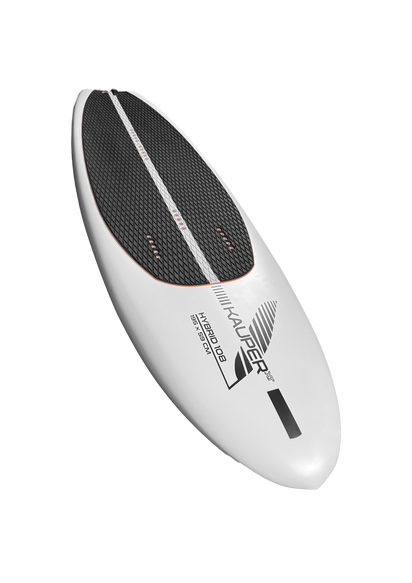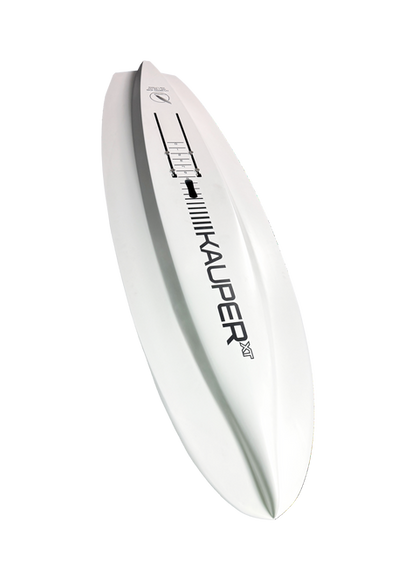

MY MIDLENGTH-BOARD

WEIGHT & SIZES

All weights are approximate.
INNOVATIVE SHAPE
FEATURES

Low-Drag-Shape
It has long been known from regatta sailing that length matters. However since foils have had a significant influence on boat design in the America's Cup, the hulls look completely different, because the most important characteristic is to get on the foil with as little wind as possible. It is precisely this characteristic that is equally important for a wing foil board, which is why I have adopted similar shape characteristics from the current America's Cup boats for my mid-length board. This can be seen in the hump at the bow, which continues like a keel to the stern of the board. This shape means that the board generates significantly less drag when riding in displacement mode. Even with just a little pull from the wing you reach a certain speed where the foil starts to develop lift. This already lifts the board slightly out of the water and the wetted area on the board is considerably reduced, which reduces the drag even further. As a result the speed increases further and it is easier to get onto the foil. Furthermore this special shape of the underwater hull ensures that my board is extremely stable against tipping. Standing up from a kneeling position to an upright position is now really easy and also helps less experienced riders to get on the board.
Hump
The hump in the bow cuts the surface of the water and does not bump into choppy water or waves. This ensures that the board maintains its speed once it has been pumped up and is not slowed down again by oncoming waves. Every rider knows exactly this situation in light winds and choppy water conditions. You pump with the wing and are happy that the board is picking up speed, but then a small wave comes along and you almost lose all the speed you have gained and have to start all over again. This hardly ever happens with my board.
Another advantage of the hump on the bow and the keel on my board are touchdowns with the board. Even if you are very fast on the foil and ride hard into a wave you notice the touchdown much less than on boards with flat or concave shaped bottoms. Here too the speed of the board is hardly reduced by the touchdown and the rider retains his balance.


Keel-Profile
The entire shape of the board is designed for low drag. This is why the keel in the underwater hull runs all the way through to the tail of the board in a flow-optimized profile. The slightly wider trailing edge of the keel in the tail ensures that the turbulence behind the board remains small even when the board is not really going straight through the water. The keel also gives the board really good directional stability which is a great advantage when pumping in displacement mode. This means you don't have to constantly correct the direction of travel of the board with the wing, but can concentrate fully on pumping. The side areas next to the keel are not straight, but shaped in a “V” to effectively drain the water sideways in the event of a touchdown. The wider tail provides more stability when getting on the board.
Surfboard-Outline
I don't just want my board to get as easy as possible on the foil, I also want it to have a wide range of uses. For me this also includes the use in waves with the wing or parawing. That's why I opted for an outline like a surfboard. This outline supports my goal of generating hardly any resistance and at the same time ensures that the board does not get caught during foiling. Due to the narrow keel on the bottom side I was able to shape the board a little wider without losing performance, but I was able to gain more stability and also more freedom of movement for my stance positions on the board. This freedom gives me more room to maneuver, as I simply have more space on the board. Heavier riders also find it easier to find their balance on the board.

CONSTRUCTION
“My board has to be light and is only made with high-quality carbon fibers”
EPS-Core
A lot has happened in the materials sector in recent years. In particular there has recently been an interesting development in foams for the core of the board. I actually wanted to use a closed-cell XPS core for my board, which was to be brought down to a low weight using hollow chambers. However the supplier of our cores presented me with an EPS core that has very low water absorption and therefore offsets the actual advantage of XPS cores. This EPS core has further reduced the weight of the board and also provides a better connection between the carbon laminate and the core. In the pictures you can clearly see the indentations in the EPS core on the top of the board where the PVC hard foam inserts (AIREX) will later be inserted. This is exactly where the rider usually places his heels, which puts a high point load on the board. A thin AIREX panel absorbs these forces well and ensures that the laminate is not damaged there.


Carbon-Laminate
My boards should always be light, even very light. That's why I only use carbon laminates. The layer structure varies across the board at the different positions. For example more carbon is used around the railboxes for the foil to ensure sufficient stability there. In areas where there is less stress, the layer structure is smaller so that the overall weight of the board remains low. My board is manufactured in a CNC-milled and hand-polished two-piece aluminum mold. A 40-ton press and very high temperatures are used to bake the carbon laminate. This is the only way the laminate can achieve the strength I want as standard for my board.
AIREX-Inserts
High forces occur around the railboxes for the foil which must be absorbed. Neither an XPS nor an EPS core can permanently withstand such forces without additional reinforcements. That's why I have used a large sheet of rigid PVC foam (AIREX) in my board, see the yellow body in the picture. This AIREX contains the two railboxes and the handle. An AIREX strip is also glued into the slots underneath the AIREX in the picture, which goes all the way through to the deck of the board to ensure structural stability.


Railbox
For me it has never been an option to use inexpensive plastic railboxes in a high-quality carbon board. In my opinion these plastic parts simply do not correspond to the loads that occur in a modern wingfoil board. I therefore opted for a very elaborate construction with full carbon boxes. These boxes are made from an industrially produced square carbon profile and inserted into the AIREX insert with additional carbon layers. A strip of ABS plastic serves as the top layer. This entire package is manufactured separately in advance and inserted into the board as a whole during the lamination process. When the cured board comes out of the mold the slots are cut out with the CNC router. The railboxes have a usable length of 37 cm and a distance between them of the now standard 90 mm. The opening on the railboxes is at the front end and slightly longer so that the T-nuts can be left for mounting on the foil.
My board is supplied with stainless M8 countersunk screws and the matching T-nuts.
Pad
The pad is the direct connection between the rider and the board. If the pad is slippery the ride always feels spongy and you can't move the board as desired. My pad has a so-called CNC-milled diamond structure, which has many edges on the surface and thus ensures a firm footing on the board. This works equally well whether you are riding barefoot or with booties. For riders who are riding strapless the ideal standing position on the board is very easy to find because my pad has two layers and the bottom layer is orange. A quick glance down to the feet shows the clearly visible position of the inserts for the straps and this is also where the ideal standing position is.
There are 5 positions for mounting the straps. This means that every rider is likely to find his own individual setting.
The pad lies in a slightly concave upper side of the board and offers an ergonomically comfortable standing position.

BOARDBAG
The matching Boardbag is inclusive.

Why buy a HYBRID-Board?

All prices incl. board bag and M8 countersunk screws and T-nuts
All prices include VAT plus shipping costs.All weights are approximate.
In accordance with the distance selling regulation for cross-border deliveries of goods to private individuals that will apply in the EU from July 1st, 2021the VAT rate of the destination country is calculated.














